Social Media Listening 101: The Practical Guide for Marketers
Unlock the power of social media listening to boost your marketing strategy with actionable insights, trend spotting, improved brand reputation management.
November 14, 2024
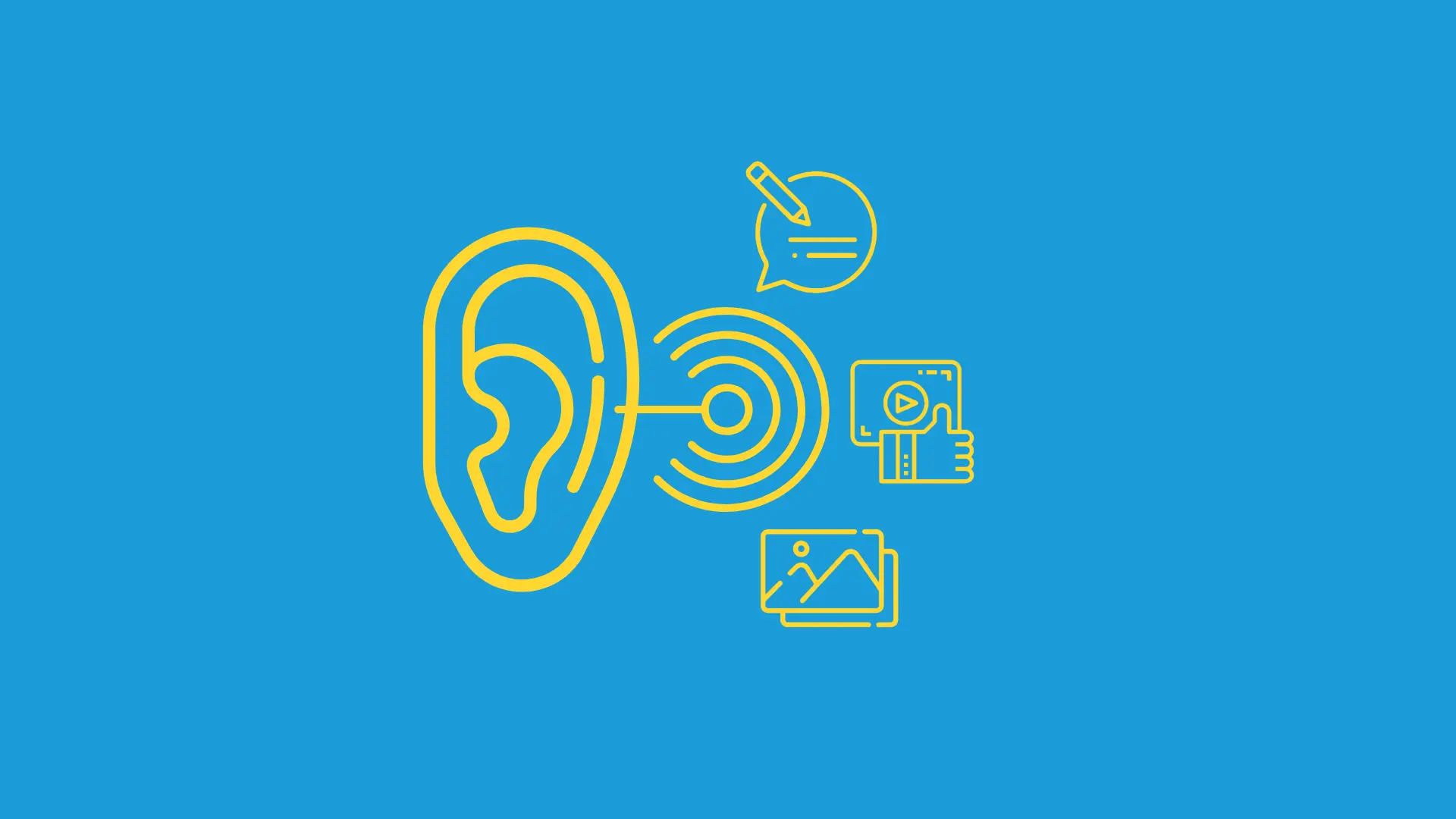
Is your target audience discussing sustainable packaging in Facebook groups? Or talking about lunch break workouts on Reddit?
Direct customer feedback is important, but it's rarely the full picture. Every day, people share valuable insights online—usually without you knowing.
That's where social media listening steps in. It helps you uncover industry trends and generates actionable insights you'd otherwise miss.
In this guide, we'll cover everything you need to know about social media listening—from strategy setup to real-world case studies.
What is social media listening?
Social media listening means analyzing conversations about your brand, industry, specific keywords, and competitors across various online channels.
It goes beyond tracking direct mentions of your brand and helps you understand emerging customer needs and find potential business opportunities.
It’s usually done using specialized software and can cover social networks, forums, platforms like Reddit and Quora, and more data sources.
The goal? To transform scattered social media conversations into business strategic insights and jump on relevant social media trends.
Social media listening vs social media monitoring
Have you heard marketers mention social listening and social media monitoring?
These terms are often used interchangeably. However, they serve different purposes in your social media strategy.
Social media monitoring is about tracking real-time mentions of your brand. It's reactive and focuses on responding to immediate customer needs and improving customer experience.
Here’s an example of Wendy’s replying to a customer complaint on X (Twitter). It’s a typical social media monitoring example:
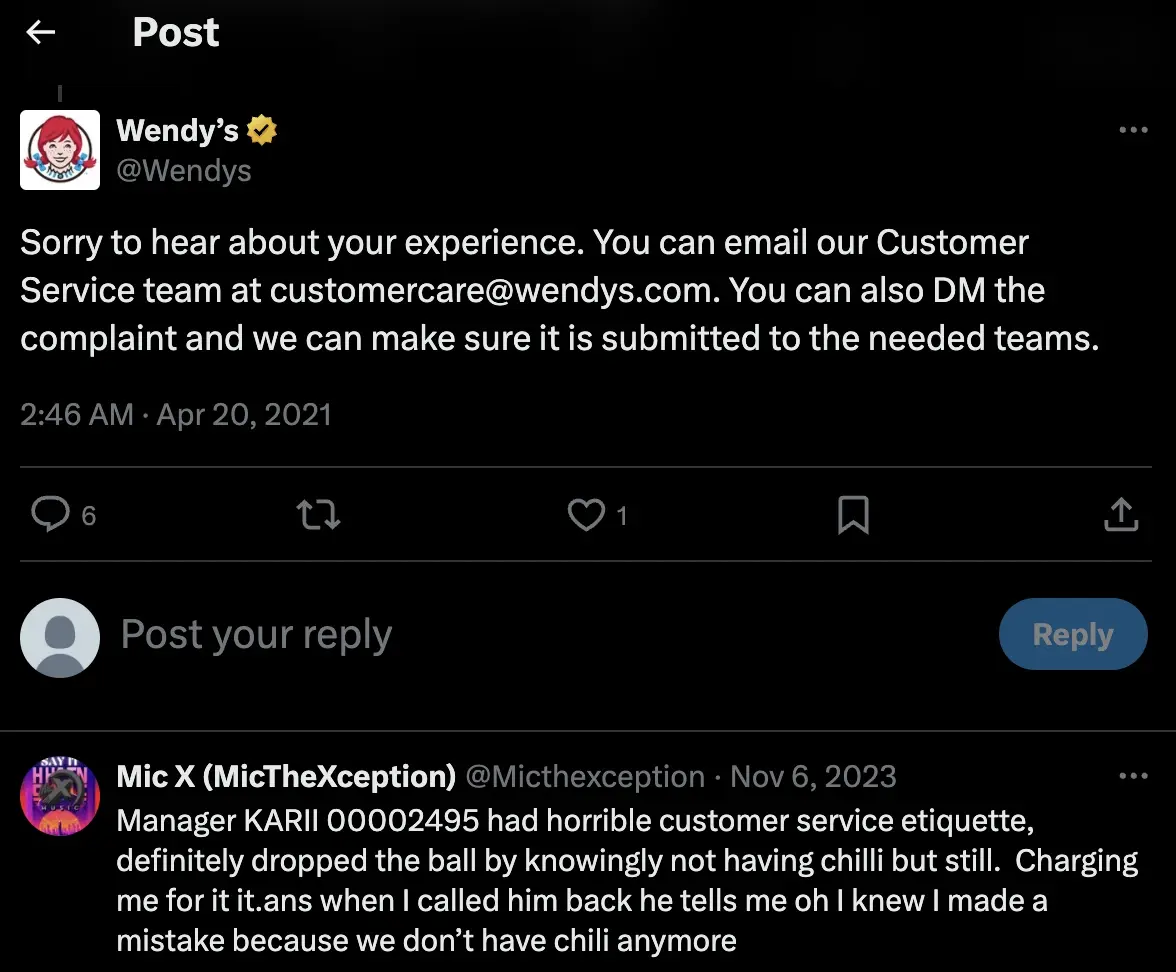
Social media listening digs deeper. It involves analyzing these mentions and other conversations to gain actionable insights. It's proactive and strategic, helping you understand the 'why' behind customer behavior and industry trends.
Let’s look at a social media listening example.
A simple promotional McDonald's purple shake turned into a viral TikTok trend when users started creating dramatic "passing out" videos after drinking it. They were also using the #GrimaceShake hashtag.
McDonald's used social listening to spot this trend and transformed their Grimace birthday campaign into a major social media success.
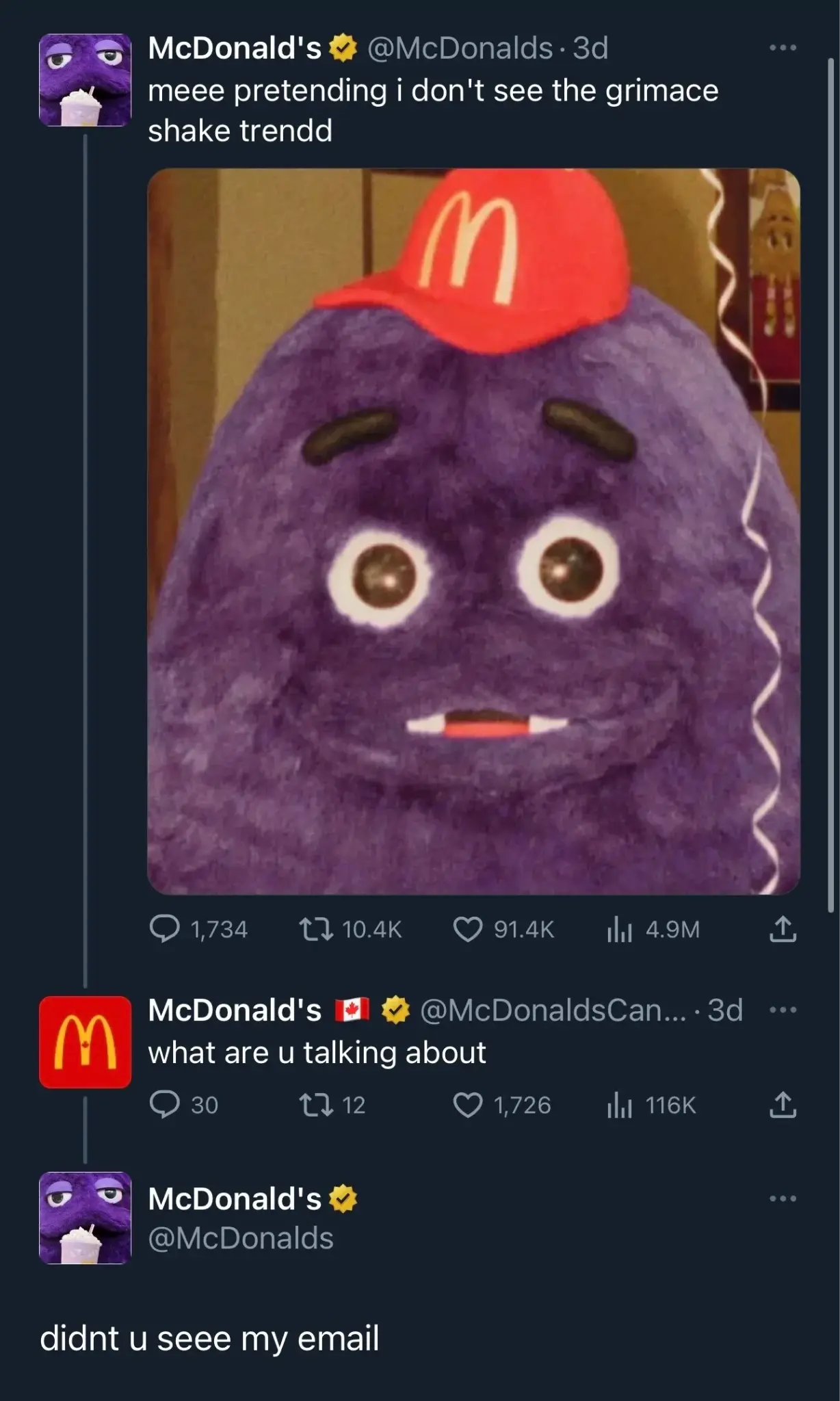
Source: Valley Central
Why do you need social media listening?
Let’s review the benefits of implementing social media listening for your business. Here’s what it helps you achieve.
#1. Improve your brand reputation
Social media listening helps you understand the deeper patterns and trends in how people perceive you—not just what they say directly about you (or to you).
It can reveal:
Your audience’s key pain points
Broader online conversations your brand could be part of
Industry problems your audience cares about most
Gaps between customer needs and current solutions
Values and topics that resonate with your target audience
Once you have these insights, you can strategically shape your brand message and offerings to align with audience values.
You can also build closer, more authentic relationships with your customers.
Take, for example, Arby’s viral Grammy’s moment. Through social listening, they noticed Twitter users comparing musician Pharrell Williams' oversized brown hat to Arby's restaurant logo.
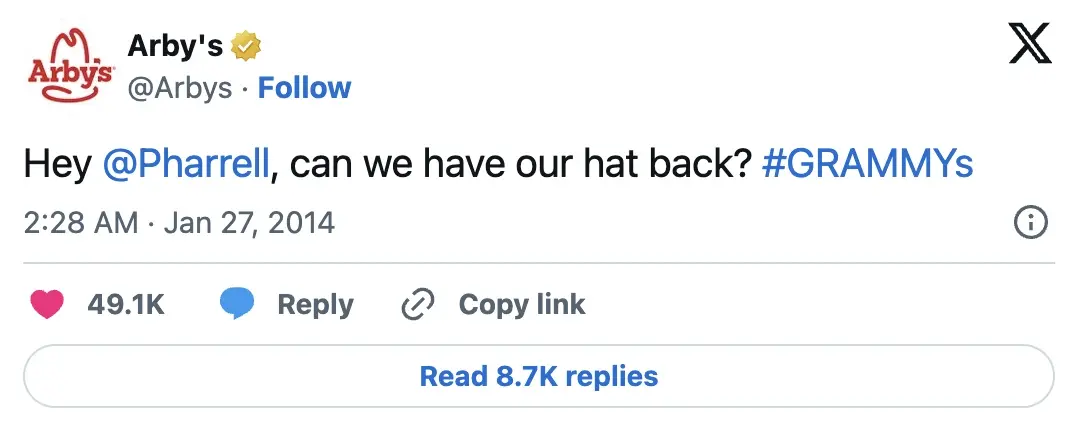
By quickly joining this relevant conversation with a tweet, they generated 84 million impressions—worth an estimated $22 million in advertising value.
This kind of opportunity would have been missed without active social listening.
#2. Make better business decisions
Tracking what people say online also lets you turn conversations into actionable insights for your marketing strategy.
Whether it's product development, content ideas, or marketing campaigns—you'll base your decisions on real customer discussions, not assumptions.
For example, you might discover when and where your audience is most active, helping you adjust your content strategy to match their habits.
#3. Prevent and manage crises
Social media listening also helps you with crisis management.
By monitoring sentiment and conversation patterns, you can spot and address customer concerns almost instantly.
You can also detect serious issues before they escalate into social media crises.
For instance, imagine people start questioning an ingredient in your product.
You can track this negative sentiment in real time. Then, instead of waiting for the issue to explode, proactively communicate about the ingredient’s safety and benefits.
#4. Spot trends before your competitors
You can identify emerging conversations and customer behavior shifts.
While your competitors rely on historical data, you'll know what your audience wants next.
For instance, you might notice new ingredients gaining popularity in forums long before they hit the mainstream market.
#5. Build stronger customer relationships
Finally, social media listening helps you understand what your audience truly cares about—even when they're not talking directly to your brand.
This helps you improve content creation and develop offerings that resonate with their needs.
You can also create trust by showing your customers that you truly care.
Let’s look at another example.
Stanley, a thermal drinkware brand, showed the power of social listening when they spotted a viral TikTok.
Their customer's car had burned down, but her Stanley cup survived with ice still inside.
The company's president saw this opportunity and offered to replace her car, turning a viral video into an even bigger PR win.
How to build an effective social media listening strategy in 7 steps
Let’s explore how you can get from zero to a social media listening hero.
1. Set clear social media listening goals
Before choosing social listening tools or diving into social media analytics, decide what you want to achieve.
Your goals will shape which social media channels to track, what social listening data to collect, and which metrics and benchmarking to focus on.
Start with listing your overall business objectives. For example:
Tracking social media trends and new market opportunities
Improving product development based on customer feedback
Understanding your target audience's needs and pain points
Monitoring brand sentiment and reputation
Identifying potential influencers and partnership opportunities
Measuring marketing campaign performance
These goals will then translate into specific metrics, such as:
Share of voice (SOV) compared to competitors
Brand sentiment analysis (positive/negative/neutral)
Engagement rates across social platforms
Real-time crisis management response rates
Influencer reach and impact metrics
Marketing campaign ROI
For example, if your goal is brand reputation management, you'll focus on metrics like sentiment analysis, brand mentions, and share of voice.
If you're interested in product development, you'll track customer feedback, pain points, and relevant conversations about specific features.
2. Pick the right social media listening tool
With your social media listening goals and tracking needs defined, you can choose the best software to help you get there.
Various social listening tools offer different features and capabilities. Make sure to evaluate them based on your specific needs.
Here’s what to consider:
Platform coverage across social networks and other data sources
Enhanced search settings (e.g., Boolean operators like AND, OR, NOT to combine keywords, exclude terms, and set up complex queries, AI search, custom filters)
Real-time monitoring and notification capabilities
Advanced analytics for sentiment analysis and brand monitoring
Report customization and benchmarking features
Team collaboration and automation options
Integrations with your existing marketing tools
For example, Talkwalker offers AI-powered social listening across 30 social platforms and 150 million websites globally.
It offers advanced analytics with real-time insights about your brand reputation, industry trends, and sentiment.
At the same time, it’s extremely easy to set up and use.
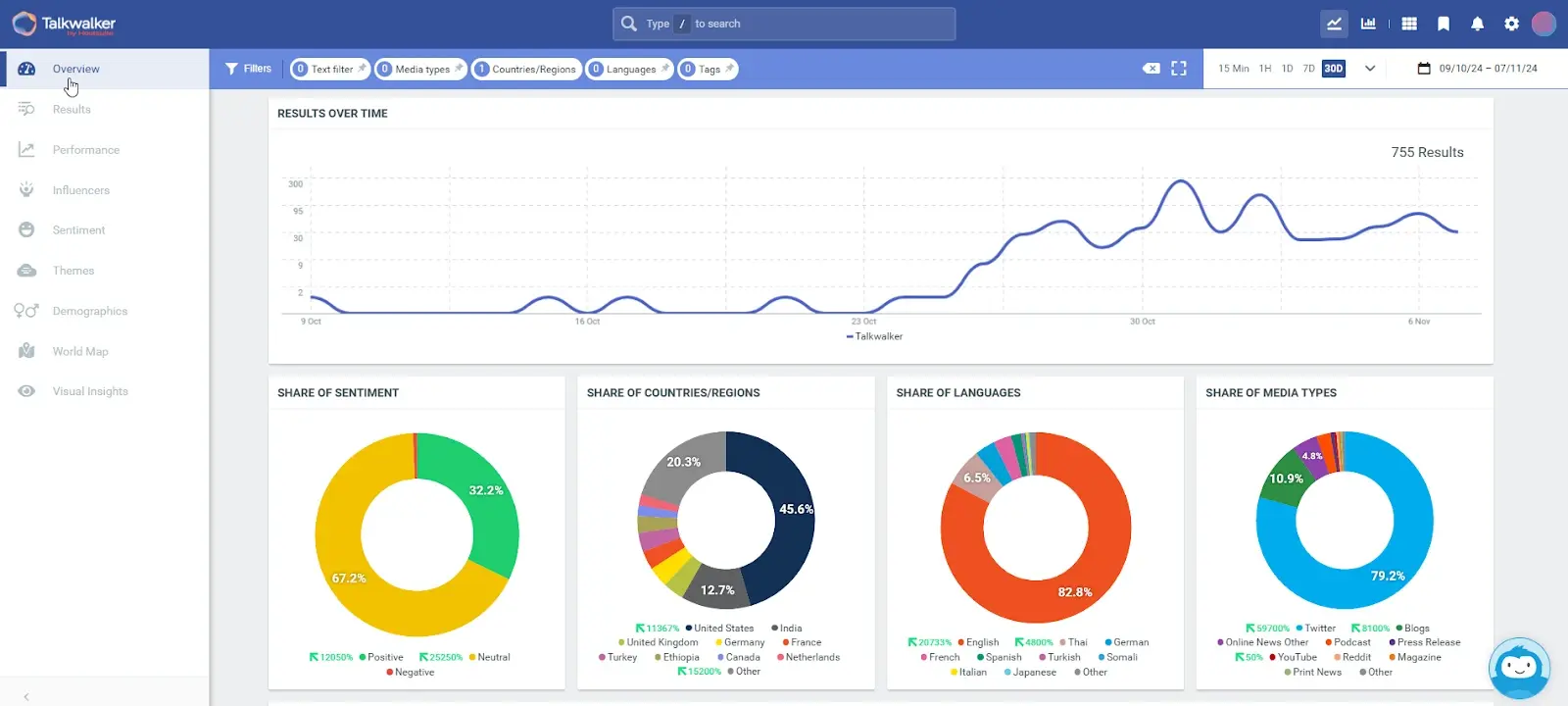
3. Choose what to monitor
Once you’ve selected a tracking tool, you can start setting up your social listening project.
Start with listing specific topics and keywords you will monitor.
Think about all the different ways people talk about your brand and industry across social platforms. Here’s what you can track:
Brand and product mentions
Your brand name and common variations (e.g., “McDonalds” or “McDonald’s)
Untagged mentions of your brand (when people discuss you without @ mentions)
Common misspellings (like "McDolands" or "MacDonalds")
Product names and features
Your social media handles across different platforms
Specific campaign terms and brand hashtags
Industry conversations
Industry trends and hot topics (e.g., “healthy fast food”)
Relevant conversations about your market (discussions about problems your products solve)
Popular hashtags in your field (both industry-specific and trending topics)
Competitor movements (like new product launches)
Key influencers and their content
Discussions on specialized forums (like Reddit threads)
Visual monitoring
Modern social media listening tools, Talkwalker also offer AI-powered image recognition to track.
Your logo in photos
Product appearances in videos
Untagged visual brand mentions
For example, here’s what this would look like if you were launching social listening for McDonalds using Talkwalker:
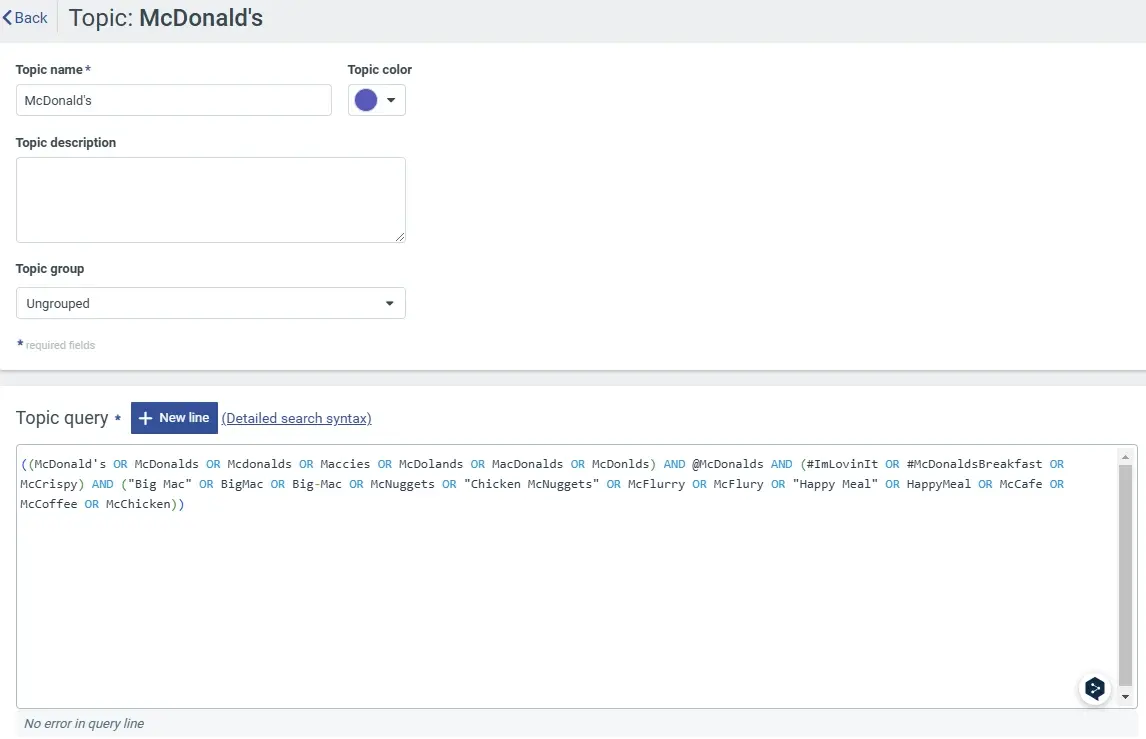
__CONTENTFUL_MEDIA_5__
4. List the channels you will track
Next, select the online platforms to monitor.
Different channels attract different audiences and offer varying types of data.
For example, TikTok and Instagram are visual brand monitoring and spotting emerging trends.
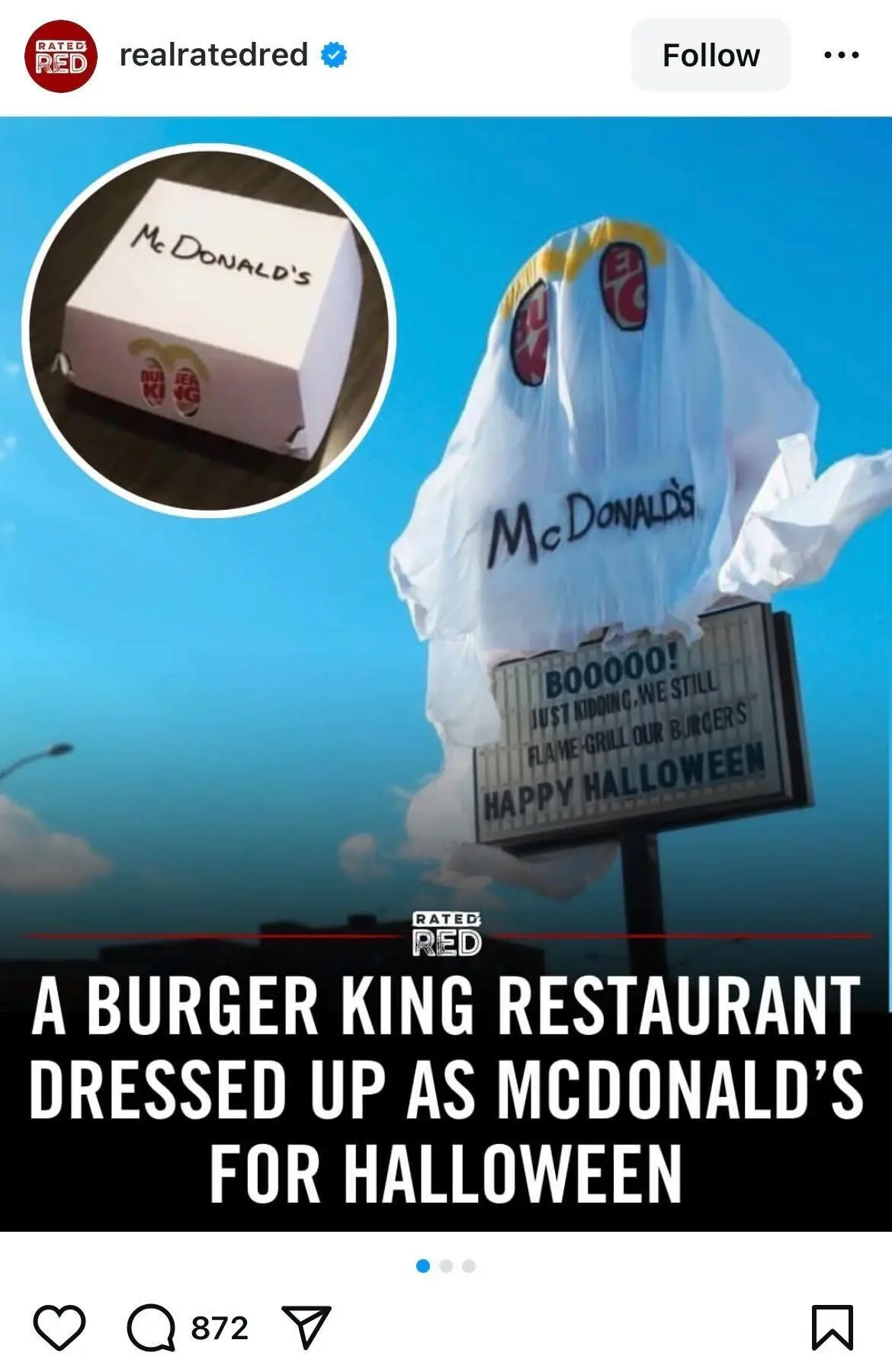
At the same time, Reddit and specialized forums often reveal deeper customer sentiment and detailed feedback.

Here's what you can monitor:
Social networks (Instagram, TikTok, X, LinkedIn) for real-time conversations
Discussion forums (Reddit, Quora) for detailed product feedback
Review sites for customer experience analysis
Industry blogs and news sites for crisis management
Specialized platforms specific to your market for niche conversations
Always focus on channels that are relevant to your audience. Whether it’s TikTok for Gen Z buyers or LinkedIn for B2B conversations.
For example, here’s what you could track for McDonalds using Talkwalker:
Instagram and TikTok for user-generated content and food photos
X for real-time customer feedback
Reddit's r/FastFood and r/McDonalds for in-depth discussions
Review sites like Yelp for local restaurant feedback
News sites for broader industry coverage
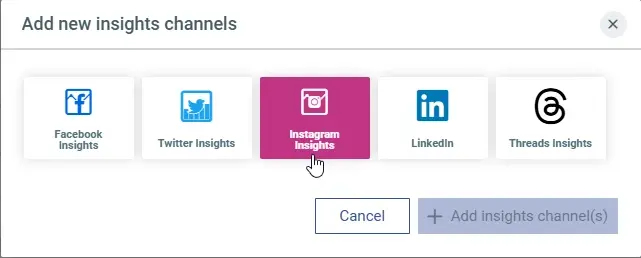
5. Analyze your competitors
Social media listening is also a powerful tool for competitor analysis and finding new business opportunities.
Monitoring your rivals helps you spot gaps in their strategy, identify important customer pain points, follow relevant conversations, and get ideas for your marketing efforts.
Let’s look at an example.
Through social listening, Domino's discovered that customers were comparing their pizza unfavorably to competitors like Pizza Hut and Papa John.
To tackle this, the brand completely remade its recipe and launched the "Pizza Turnaround" campaign, openly addressing the product flaws.
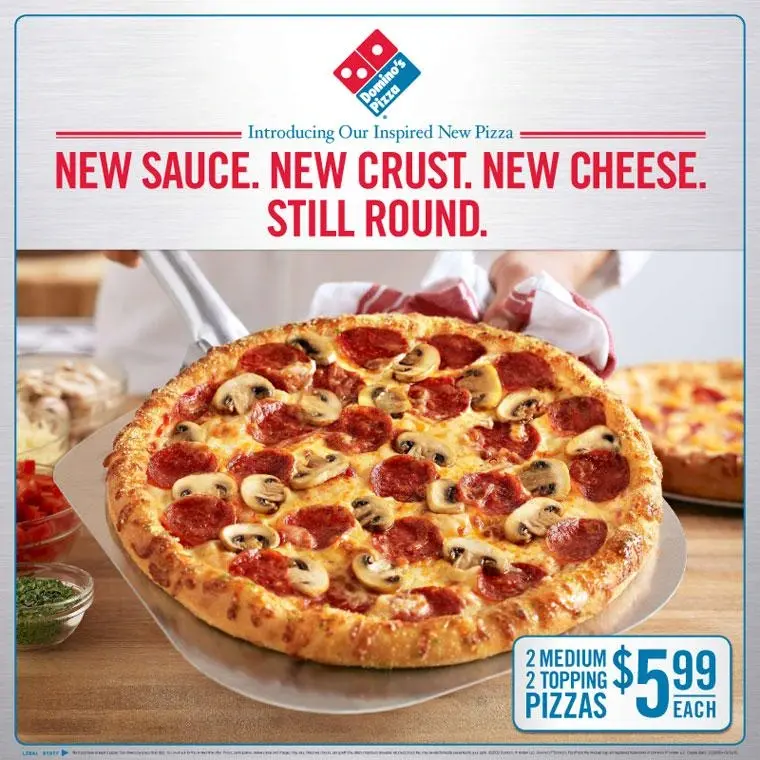
Source: The Right Brain Studio
The strategy worked—between 2010 and 2020, Domino’s global sales more than doubled.
And by 2018, they had officially overtaken Pizza Hut as the largest pizza company in the world in terms of sales.
Here’s how you could start listening to conversations about your competitors using Talkwalker:
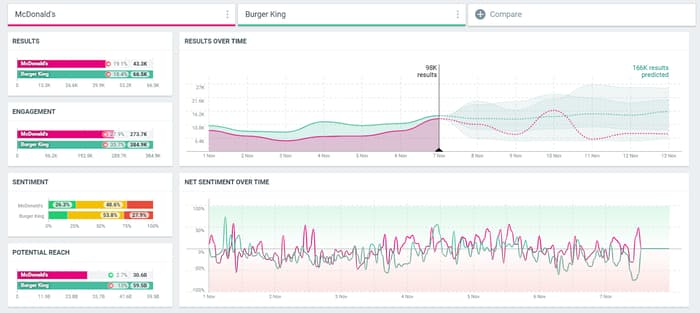
With this analysis, McDonald’s could spot opportunities like menu gaps their competitors aren't filling or service issues they can highlight in marketing.
For instance, Burger King used the backlash about Wendy’s plan to implement "surge pricing" (price increases during peak hours) in their restaurants.
They used this theme to create engaging push notifications for their app users.
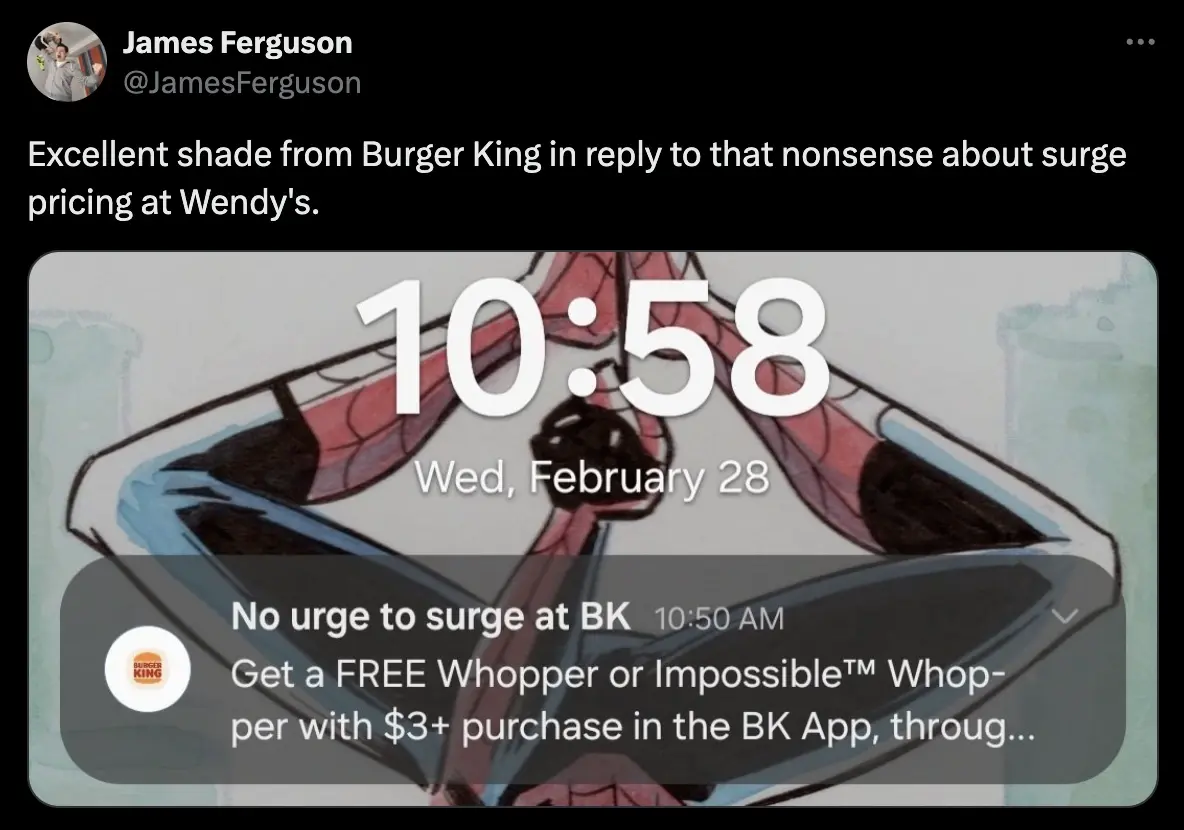
6. Create action plans
Once you’ve finished setting up your social listening project, design processes for its ongoing implementation.
Creating clear action plans will help your team transform social listening data into tangible business results.
Here's what this plan should include:
Clear ownership and team responsibilities
Response time requirements for different scenarios
Insight distribution channels and frequency
Success metrics and reporting structure
Escalation procedures for critical situations
Integration with existing social media management tools
Start by determining who owns your social media listening strategy. Often, your social media and PR specialists would take the lead.
This team will be responsible for monitoring conversations, analyzing social media trends, and distributing insights across your organization.
They'll also need clear guidelines about when and how to respond to different types of mentions.
You can build a response workflow to make it easier for everyone. It would outline how to handle different scenarios, pass information across teams, etc.
Here’s what it might look like:
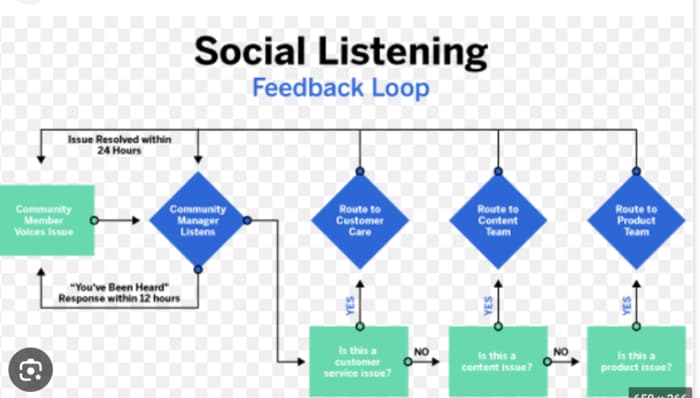
This is especially easy to implement if you’re using Talkwalker.
It uses AI to segment, filter, and cluster your data in seconds. This way, you can categorize topics and plan your response actions accordingly.
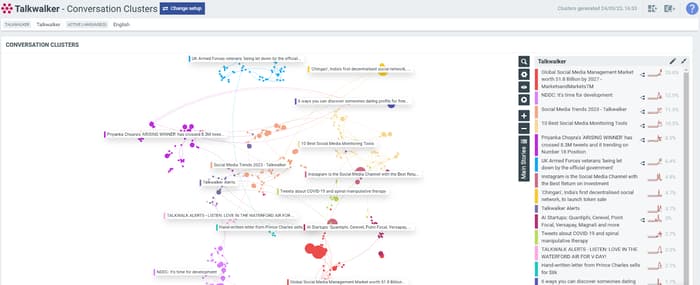
You can also reply to mentions, comments, and requests directly from the platform.
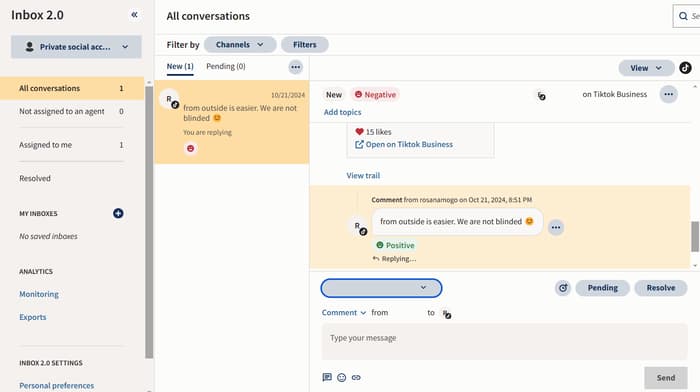
Other important items you might want to include in your response guide include:
Tiered response times based on mention types (e.g., 30 minutes for potential crises)
Regular reporting and report templates
Specific success metrics to track (e.g., average response time, social media sentiment, etc.)
Tools and software workflows and tips
Processes for regular reviews and updates of the guidelines
7. Test and refine your strategy
To get the most from your social listening efforts, continuously optimize your approach based on performance.
Start with testing your initial setup.
Run a 30-day test period to establish your baseline metrics. During this time:
Track which keywords bring useful conversations
Identify which social channels matter most
Check if sentiment analysis matches the reality
Test if your alerts catch important mentions
After this test period, you'll know exactly what to keep, what to remove, and what to adjust in your social listening setup.
Next, work on tracking your key social listening objectives.
Go back to step one and review the target metrics you established—e.g., share of voice, sentiment analysis trends, etc.
You can also analyze the secondary effects of social media listening. For example, have your efforts helped the product team develop a new tool or feature?
To create a transparent and efficient process, establish a cadence of:
Weekly reports to check quick-win metrics like engagement and spot emerging trends
Monthly analysis to compare results against your target metrics and identify long-term trends
Quarterly action plans to update your social listening settings and refine your response workflows
From here, you can work on improving your strategy.
This could mean removing irrelevant keywords that create noise, adding emerging terms and trending topics, tracking new channels, and even revising your goals.
The top 2 social media listening tools
As you can see, selecting the right social media listening tool is key to achieving great results. It’s the only way to collect quality data and use it to improve the bottom line.
Let’s review the top options you can choose from.
Talkwalker
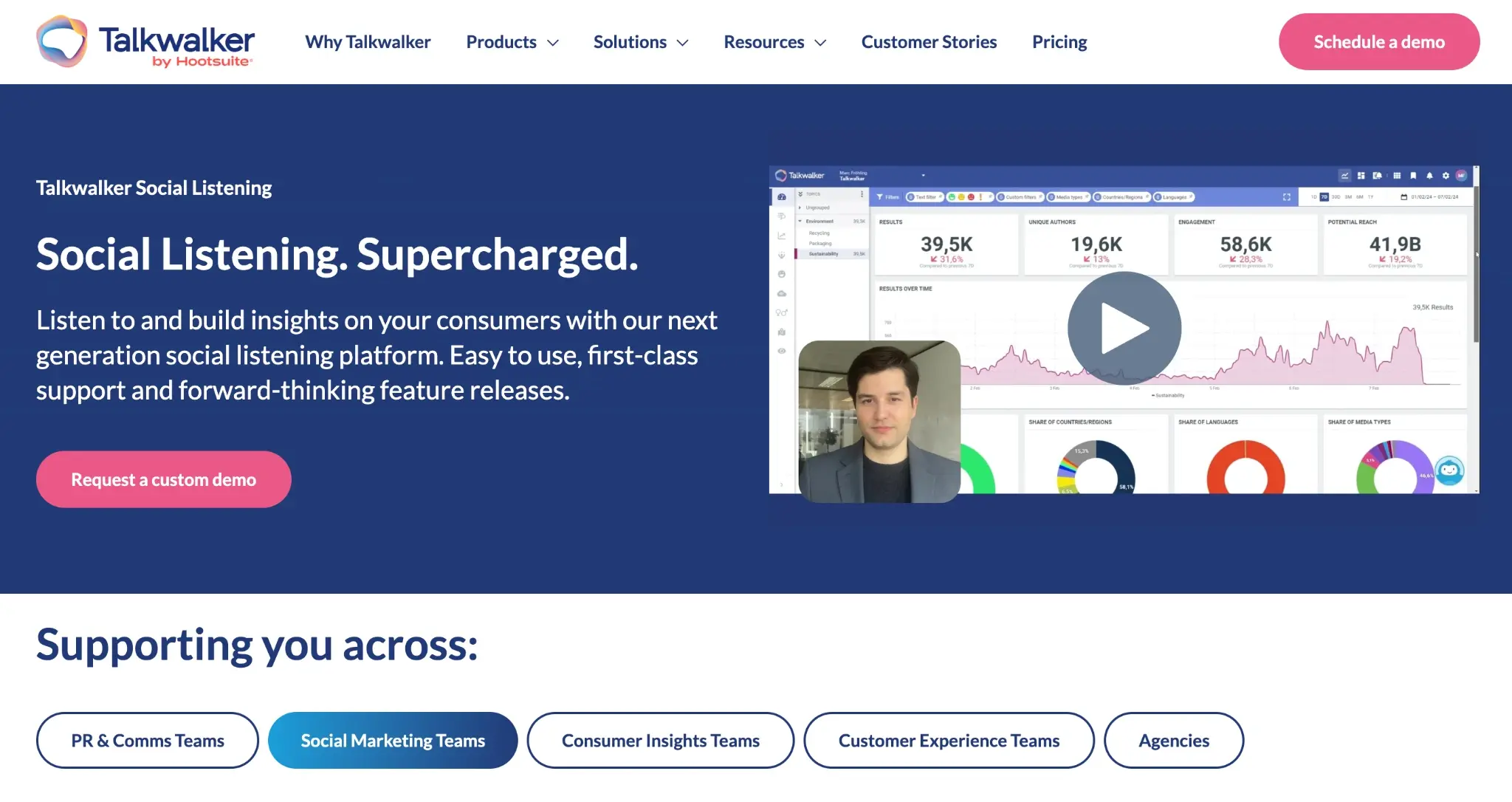
Talkwalker is a listening platform that helps brands understand what their consumers say online.
It’s an easy-to-use tool that covers 30 social networks and 150 million websites globally.
Talkwalker combines advanced AI with powerful search features to help you stay on top of all important conversations.
It also generates all kinds of useful insights, from sentiment metrics to descriptive AI summaries for your analysis.
Key features:
AI-powered insights with Yeti assistant
Advanced Boolean search capabilities for complex search requests
Customizable dashboards for actionable insights
Real-time alerts for trend monitoring
Sentiment analysis for customer feedback
Influencer discovery and assessment
Visual content analysis for images and videos
Conversation Clusters for trend visualization
Hootsuite
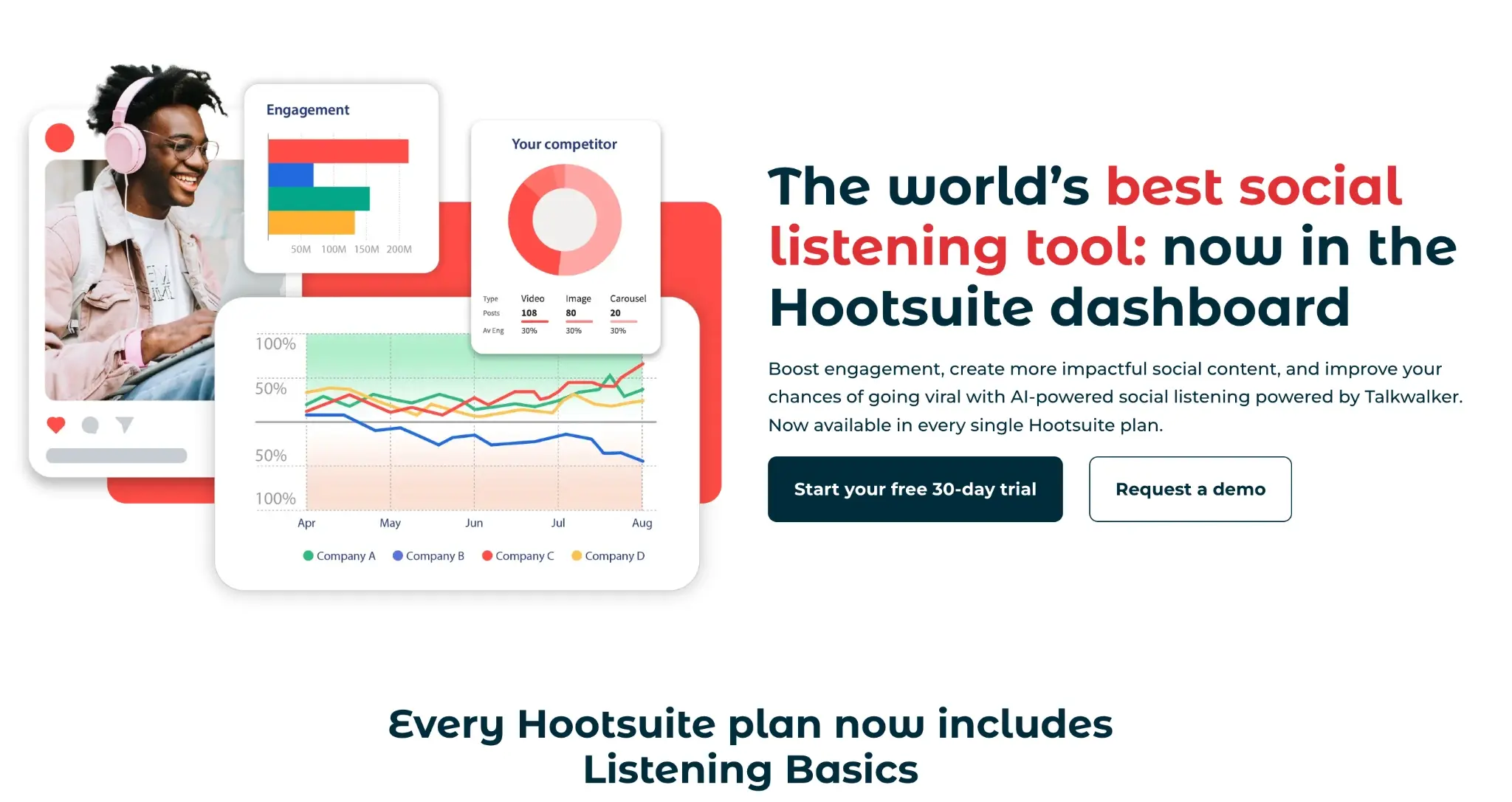
Hootsuite integrates social media listening capabilities directly into its social media management platform.
This allows teams to monitor brand mentions while managing their social presence.
Hootsuite also turns monitoring into immediate action.
From one dashboard, teams can track mentions, analyze sentiment, spot trends, and immediately respond or create content based on these insights.
Key features:
Quick Search for brand mentions and trending topics
AI-powered sentiment analysis
Combined publishing and monitoring dashboard
90-day trend predictions
Visual recognition for videos, memes, and GIFs
Peak detection for engagement spikes
Custom report builder with automatic dispatches
Before we wrap it up: check more social listening examples to inspire your strategy.
Conclusion
Social media listening helps you understand what people say about your brand and industry online and spot new opportunities.
It can guide your content strategy, community efforts, and even product development.
To get started, set clear goals and choose what to monitor.
Then, pick the right tool and create action plans for your team.
Finally, keep testing and improving your approach based on results.
Ready to start listening? Try Talkwalker to discover what your audience thinks and talks about in real time.
